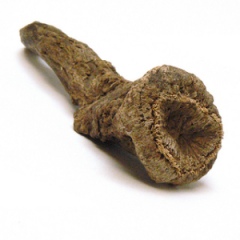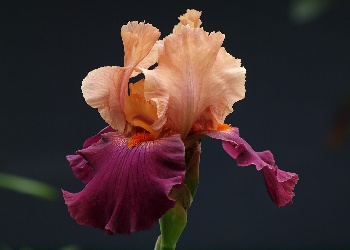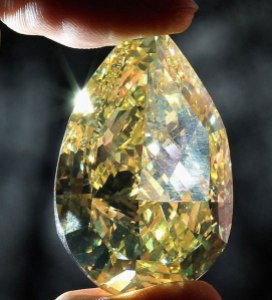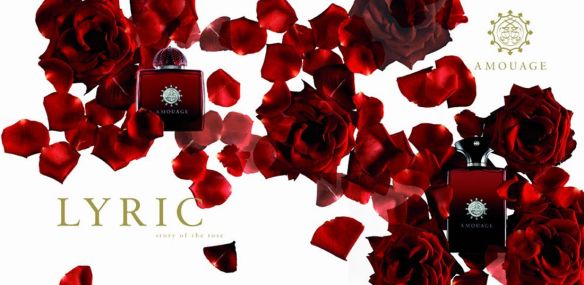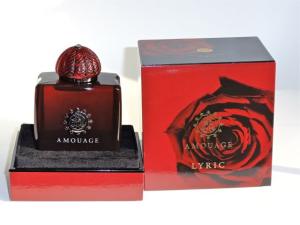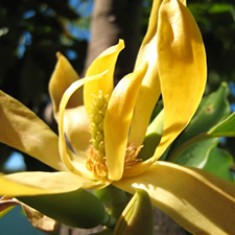 In 2010, the royal Omani perfume house, Amouage, launched a new line entitled The Library Collection which was meant to be a “poetic homage to the art of living” and inspired by the concept of memories as treasured books in a library. Just a month ago, in mid-April 2013, Amouage added a seventh “book” to its line, this one created by Alberto Morillas and Pierre Negrin. Opus VII is described as “a green, woody and leather fragrance evoking the juxtaposition of harmony with the intensity of recklessness.” It is a difficult, complex, assertive and very masculine scent that takes you to the heart of darkness in a smoky oud jungle populated by ferocious big cats.
In 2010, the royal Omani perfume house, Amouage, launched a new line entitled The Library Collection which was meant to be a “poetic homage to the art of living” and inspired by the concept of memories as treasured books in a library. Just a month ago, in mid-April 2013, Amouage added a seventh “book” to its line, this one created by Alberto Morillas and Pierre Negrin. Opus VII is described as “a green, woody and leather fragrance evoking the juxtaposition of harmony with the intensity of recklessness.” It is a difficult, complex, assertive and very masculine scent that takes you to the heart of darkness in a smoky oud jungle populated by ferocious big cats.
According to the Amouage press release quoted by CaFleureBon:
Opus VII literally stands out from the previous six editions as it is the first to use a black flacon with gold criss cross lines; an allegory of the mind when thoughts are subjected and diverted. The use of galbumum and violet in Opus VII are integral to the composition and Christopher [Chong]’s vision.
 I don’t see violet listed as one of Opus VII’s notes which — according to both Amouage‘s website and Fragrantica — consist of:
I don’t see violet listed as one of Opus VII’s notes which — according to both Amouage‘s website and Fragrantica — consist of:
top: Galbanum, Pink Pepper, Cardamom, Nutmeg, Fenugreek
heart: Agarwood Smoke, Patchouli, Ambrox [synthetic amber], Leather, Ambergris
base: Costus Root, Muscone [synthetic musk], Sandalwood, Olibanum [Frankincense], Cypriol [a woody note with earthy and spicy nuances]
As always with Amouage, understanding what the perfume smells like requires understanding the more unusual ingredients that the house likes to use. In this case, one of the most important would be the Costus Root. In a long article on animalic notes, The Perfume Shrine describes costus root as “reminiscent of unwashed hair, in more intimate places than just head” and says that it is one of the elements for the trademarked perfumer’s base called “Animalis,” produced by Synarome. In a post on Animalis itself, The Perfume Shrine describes costus root as
a plant essence that has an uncanny resemblence to a mix of unwashed human hair, goat smell and dirty socks. […] It’s also part of the mysterious urinous & musky allure of Kouros by Yves Saint Laurent (which indeed features a healthy dose of costus under phenyl acetate paracresol).
Though the Perfume Shrine says that modern perfume restrictions have limited or “axed” the use of costus, it is a huge part of Opus VII on my skin.
Another big element is Fenugreek, a plant whose dried leaves or seeds are often used in Middle Eastern or Indian cuisine. In fact, I have a large bottle of it in my pantry right now. Fenugreek has an extremely difficult scent to describe; if you’ve ever smelled it, you’ll know it right away, but otherwise, it’s a little complicated. Basically, it’s a very green aroma that is simultaneously sweet, herbaceous and extremely pungent. Though Wikipedia says that it’s called Methi in India and is a key component of some Indian dishes, to me it evokes Middle Eastern or Ethiopian food much more. It is a key ingredient in Persian Ghormeh Sabzi which Wikipedia says is considered to be one of Iran’s national dishes. Whatever its uses, fenugreek is one of those ingredients that, after you eat it, will ooze and seep out of your pores for days in a slightly sour, stale smell. As the Perfume Shrine explains,
An opaque, rather bitter smell with a nutty undertone, it traverses the urinary track to scent a person’s urine as well as their sweat and intimate juices. Its seeds’ odour is comparable to thick maple suryp. Fenugreek is featured in many fragrances which have rippled the waters of niche perfumery with pre-eminent examples Sables by Annick Goutal and Eau Noire by Christian Dior (composed by nose Francis Kurkdjian). Everytime I smell them I am reminded of the intense flavour that this spice gives them. [Bold font emphasis added.]
If all this talk of ingredients with sharp, bitter, animalic and/or urinous aromas is giving you pause, well, I’m sorry to say that both notes are key to understanding Opus VII. I could simply mention “fenugreek” and “costus root” all day long to you but, unless you know what that really entails, you won’t be prepared for the complicated, difficult scent that is Opus VII.
The perfume opens on my skin with an immediate burst of oud backed with something lemony that has a strong nuance of urine, along with the darkest of green notes and leather. Woods that are deeply smoky and dark sit atop pungently herbaceous sharp fenugreek with slightly intimate animalic musk, earthy, spicy elements, and sweetly bright, green patchouli. It is a vision of darkness, black and green, the innermost recesses of a forest where a golden jungle cat slithers, slinks and prowls in the shadows before releasing a guttural “rowwwwwwrrrr.” In the footsteps of that opening burst, there are other notes which quickly appear. There is brightly green galbanum that feels almost citric-like in its surprising freshness but which has a dark, liqueured undertone. Pink peppercorns and sharp smoke — black, acrid, and burning like a forest on fire — also join the dance.
Few of the notes besides the smoky oud have a chance of competing against the raw animalism of Opus VII’s opening minutes. If you’ve ever been to the wild cat enclosure of a zoo, you’ll know the smell. And, to detect it here, even in a less concentrated, milder form, is a complete shock to the system. It truly feels like a panther or cheetah’s ferocious growl: urinous, like animal droppings, but also musky with a faint tinge of dirty hair underneath. It’s lemon-tinged and sharply evokes YSL‘s vintage Kouros for me, albeit in a significantly softer, milder, tamer manner in Opus VII’s early stage. I lack the guts to be able to wear Kouros myself, but I absolutely adore it on a man and think it’s an incredibly sexy scent. However, that sharply animalic note — often described by some as resembling “urinal cakes” — makes vintage Kouros a deeply polarizing fragrance. I suspect the same will be true of Opus VII.
Despite the sudden shock, I found Opus VII’s opening to be completely mesmerizing, captivating and fascinating. Perhaps much like a scorpion’s victim would watch its slow, ominous walk forward. Opus VII is, on the one hand, exactly like a jungle on fire with its earthy, rooty, dark floor kicked up by panicked animals in full flight, leaving behind leathered, slightly urinous droppings in their wake. On the other hand, it is a deeply woody-leathery fragrance that feels quite smooth, with a savagely sensuous heart at its base and something that seems almost like a velvety floral. Opus VII is such a jungle scent in its opening stage: primal, elemental, ferocious, pungent, fetid, earthy, leathered and sharp — but, also, lushly green in the darkest way possible. Baudelaire would have fully approved of it and would have undoubtedly written a companion piece to Les Fleurs du Mal, entitled perhaps as La Forêt de Terreur. I approve, too, in some way that is almost partially terrified. I struggle with galbanum but, here, it’s not the brutal galbanum of Bandit or other famous leather scents. It’s not so green that it might as well be black; instead, it is smooth, spiced, warm and animalic. It’s a leathered, ambered jungle cat’s galbanum, and it actually makes me want to spray on some more.
Thirty minutes in, Opus VII starts to shift a little. The smokiness that evoked a burning jungle recedes just a hair; the perfume turns slightly more sour and urinous; the pepper notes seem blacker and far less like pink peppercorns; the leather feels darker and muskier; and the subtle spices flicker with a little more fire in the background. Much more importantly, however, the earthy elements intensify. It’s as if the jungle’s humidity hit the blackest soil at the very base of an oud/agarwood tree, turning the earth almost rooty and musky.
And, to my surprise, there is a definite impression of iris. A number of bloggers detected it, and they’re right. Though there is no iris or orris root listed in Opus VII, I’m guessing that some combination of the muscone, the earthy-woody cypriol, and the earthy elements of galbanum have created the distinct smell of iris. (Technically, “iris” as a note is impossible to create solely from the flower’s petals; it is replicated by taking rhizomes from the root, and/or often using other notes to lend to an overall impression of the flower’s scent.) I suspect that another thing that helps is ISO E Super.
Yes, Opus VII starts with a flicker of my most dreaded, hated note on earth: ISO E Super. A flicker that starts to slowly increase in volume until, eventually, it completely ruins the entire fragrance for me. A perfumer once astutely noted that ISO E Super was my “kryptonite” and, sadly, it’s true. For those unfamiliar with the aroma-chemical, you can read my full description of its pros and cons here. In a nutshell, though, it is used most frequently for two reasons: 1) as a super-floralizer which is added to expand and magnify many floral notes, along with their longevity; and 2) to amplify woody notes and add a velvety touch to the base. It seems to be particularly used in fragrances that have vetiver, with Lalique‘s Encre Noire being just one of the many examples. It is also used in a large number of Montale Aoud fragrances, to amplify the wood note to that high-decibel shrieking volume. And it is the sole focus of Geza Schoen’s notorious Molecule 01 fragrance. ISO E Super always smells extremely peppery and, in large doses, has an undertone that is like that of rubbing alcohol, is medicinal, and/or antiseptic. Some people are completely anosmic to the synthetic, while others get searing, vicious headaches from it. It is a constant base in most Ormonde Jayne perfumes, so if you get a headache from those, blame the ISO E Super. I’m not afflicted in that manner, but I cannot stand the smell in large quantities and, my God, it is strong in Opus VII’s second stage.
At the end of the first hour, Opus VII shifts in hue, turning mossily green. Visually, it is no longer the black-green of the jungle’s shadow, seeming almost ebony-like in its darkness. Instead, the perfume now reflects slightly lighter green notes, sweeter, warmer, rounder and backed by amber. The patchouli blooms, feeling as bright as emerald moss, and it helps soften the sharp edges of the urinous leather and the aggressive oud smoke. At the same time, both the iris and the fenugreek note rise in prominence. Though I’m not one to usually rave about iris, here it’s truly lovely and feels like the lushest, most buttery, velvety suede. Creamy and delicate, it has a sturdy woody-rooty undertone that prevents it from feeling gauzy, ethereal and cold. It feels like taupe-brown suede, not grey-white, if that makes any sense. Opus VII starts to turn into warmer, ambered scent where the animalic notes are softened, less sharp, dirty or urinous, the smoke is less aggressive, and the whole thing is more velvety, mossy and earthy.
Unfortunately, the start of the second hour marks an abrupt right turn in Opus VII’s development. From that fascinating start as olfactory ode to the heart of darkness in a smoky oud forest inhabited by the most powerful of leathery, ambered jungle cats alongside velvety iris and mossy green, the perfume suddenly becomes a fenugreek-oud scent — much like a dark forest through which shines the fluorescent light of ISO E Super. Sure, there are still elements of animalic musk, leather, iris, spices (cardamom, in particular) and amber, but the oud really goes into high gear here. It is always infused with the pungent, herbal fenugreek, the slightly urinous feline musk, and the sharply medicinal, astringent ISO E — and the combination just gets stronger with every minute. By the middle of the third hour, Opus VII is an oud-fenugreek-musk combination above gallons of medicinal, antiseptic ISO E Super. By the end of the fourth hour, it’s predominantly, painfully, and primarily pure ISO E Super and oud, backed by animalic, sour musk over light amber. Honestly, I preferred smelling like a panther just peed on me.
Opus VII’s drydown begins at the fifth hour. The perfume is primarily dark, peppered, woody notes headed by oud, followed thereafter by light, synthetic sandalwood (which has suddenly made its first appearance), the endless ISO E Super, a miniscule pinch of spices, and a lot of sour musk over vague, muted amber. In some odd way that I can’t explain, the whole thing feels generalized and somewhat abstract. Opus VII is also a much softer scent now in terms of sillage, becoming very close to the skin where it lingers on for another few hours. At the end, 8.5 hours in, all that really remains is a musky, spiced oud note, though tiny pockets of scent still pop up occasionally on random patches of arm for another few hours. For the most part, however, Opus VII lasted in full form about 8.5 hours on me. Its sillage was much more moderate than some of Amouage’s floral scents, never projecting in tidal waves, though the scent was still extremely powerful within its small cloud a few inches above my skin.
As you can tell, Opus VII was ultimately not for me but I do think many people will be fascinated by its dichotomy, especially men. I think the perfume will be disconcerting for others and, for women used to mainstream fragrances, it will scream “masculine” in a very negative way. Opus VII is a fragrance for people who like very aggressive leathers, ouds, sharp smoke and animalic notes — all in one — as well as those who don’t get raging headaches from ISO E Super.
I think one of the best reviews for Opus VII comes from Lucas at Chemist in a Bottle. In fact, it was Lucas who so kindly and thoughtfully sent me a small sample of the perfume as a surprise gift. In his review, entitled Black Ink, he wrote:
With the first day of sampling Amouage Opus VII I noticed that it is a perfume of two different natures. The “outer” stratum of the scent is a hard shell. The smell is dense and oily with cypriol oil. When I smell it I get a feeling like I could drown in this scent. It’s mysterious and dark suspension, a black ink that covers everything permanently, making it impossible to return to the previous state. In this kettle particles of warm and spicy cardamom float, blended with a resinous smell of galbanum.
In no time the dark tincture smell gets enriched by the aroma of sandalwood. It’s raw, dirty, not smooth but full of splinters that can hurt your hands when you want to touch it and feel the structure of the wood. Neither musk is soft here. In Opus VII musky tones are animalic, wild and untamed which is additionally pronounced by the earthy, almost rotten patchouli. Maybe it’s just my nose (not used to smelling scents like this one) but so far this Amouage is a beasty creature on me.
Once you survive through the “outer” stratum of Amouage Opus VII the different story begins. After the hard shell is broken, the softer core of the scent is revealed. To me it is still dark, but now it’s more gentle and chic like a black silk scarf. Amber creates warm and sensual aura around the wearer and olibanum adds the restrained mineral quality with a slightly salty touch. Of course oud had to find its place in the composition. Luckily it’s not very powerful. Accompannied by the leathery chords it creates this a little bit mischievous smell of tanner workshop. The smell of raw leather, pigments… it’s all in here.
In the rest of the review, which I recommend reading in full, he notes the presence of the iris note and how the final stage of Opus VII on his skin was spicy and dry. He concludes with a very apt warning: “Bear in mind – this is not an easy to wear perfume. In my opinion one has to be really self-confident and needs to have a strong personality to rock it.”
I agree very much with that last part as well as with his overall impressions of the perfume, though the details of our individual experiences with Opus VII differed. For one thing, I detected very little sandalwood on my skin until the very end. For another, Lucas has often noted that oud notes manifest themselves very softly on his skin. My skin, in contrast, amplifies certain base notes, I think, which may explain the vociferous roar of the oud. But we thoroughly unite on the issue of the raw leather and those prominent animalic notes which, as he put it so well, are “untamed” and completely “beasty” — in the full sense of that word. And, despite having perfume tastes at the opposite ends of the perfume spectrum, we both would run away from wearing Opus VII ourselves.

African lion spraying to mark his territory. Photo: Charles G. Summers, Jr. Source: WildImages on Flickr http://www.flickriver.com/photos/wild_images/2236584479/
Opus VII is a difficult, thorny scent for a variety of reasons, and it is not one which I would recommend to the vast majority of people. Though there are fascinating, intriguing and, at times, mesmerizing parts, at the end of the day, I think it’s a very masculine scent with extremely assertive edges that border on the abrasive. Some of the notes are wildly aggressive but, taken by themselves, they would be manageable. Even a jungle cat peeing on your arm can be handled, in small doses. But Amouage rarely does anything in moderation, and Opus VII is no exception. The combination of difficult, raw, beastly notes at such supersonic volume (and atop such vast lakes of ISO E Super) made much of Opus VII simply unbearable for me. If Opus VII had been a projection beast — which, thankfully, it is not — then it would have been a complete scrubber right off the bat. As it was, I tried it twice and the second time, I gave up after 6.5 hours. The second time round, the animalic notes were so prominent, I felt as if I’d been chained in a wild cat enclosure and been peed on by a vast legion of feral, growly animals who had been fed a steady diet of antiseptic oud. At $325 or €275 a bottle, Opus VII is a very expensive wildlife experience but, if you enjoy the woody heart of darkness, then give it a try.

